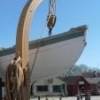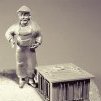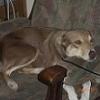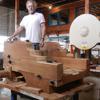-
Posts
3,081 -
Joined
-
Last visited
Reputation Activity
-
 Cathead got a reaction from justsayrow in Poor instructions?
Cathead got a reaction from justsayrow in Poor instructions?
Mikiek, in fairness to MS, the Niagara is hardly a beginner's model for someone with no prior experience. I do think instructions for kits of that complexity assume the modeler has some knowledge/experience with what they're doing. I think people really should start with a basic open boat or something before they tackle a fully rigged, armed brig or ship.
Really, it's a lot like cooking. If you try to tackle a complex French recipe when your prior kitchen experience is limited to oatmeal and ramen, you shouldn't expect the the recipe to walk you through concepts like browning, deglazing, or julienne. It's fair for that recipe to make some assumptions about the cooks' knowledge.
-
 Cathead got a reaction from dgbot in Poor instructions?
Cathead got a reaction from dgbot in Poor instructions?
Mikiek, in fairness to MS, the Niagara is hardly a beginner's model for someone with no prior experience. I do think instructions for kits of that complexity assume the modeler has some knowledge/experience with what they're doing. I think people really should start with a basic open boat or something before they tackle a fully rigged, armed brig or ship.
Really, it's a lot like cooking. If you try to tackle a complex French recipe when your prior kitchen experience is limited to oatmeal and ramen, you shouldn't expect the the recipe to walk you through concepts like browning, deglazing, or julienne. It's fair for that recipe to make some assumptions about the cooks' knowledge.
-
 Cathead got a reaction from jazzchip in Poor instructions?
Cathead got a reaction from jazzchip in Poor instructions?
After reading this thread, it occurs to me that I should bring a few copies of "good" and "bad" kit instructions to my class, so people get first-hand experience with the importance of that aspect of kit-choosing. I've seen so many examples on this board of people turned off by modelling by instructions, maybe I can head a bit of that off. Of course, that assumes anyone signs up for the class in the first place.
-
 Cathead got a reaction from Dan Vadas in Poor instructions?
Cathead got a reaction from Dan Vadas in Poor instructions?
Mikiek, in fairness to MS, the Niagara is hardly a beginner's model for someone with no prior experience. I do think instructions for kits of that complexity assume the modeler has some knowledge/experience with what they're doing. I think people really should start with a basic open boat or something before they tackle a fully rigged, armed brig or ship.
Really, it's a lot like cooking. If you try to tackle a complex French recipe when your prior kitchen experience is limited to oatmeal and ramen, you shouldn't expect the the recipe to walk you through concepts like browning, deglazing, or julienne. It's fair for that recipe to make some assumptions about the cooks' knowledge.
-
 Cathead got a reaction from jazzchip in Poor instructions?
Cathead got a reaction from jazzchip in Poor instructions?
jazzchip, for what it's worth, I am offering an "intro to wooden model building course" through my local adult-education center this spring. The goal is to focus on hands-on demonstrations and experiences with basic aspects of aircraft and ship modelling, right down to having a few open kit boxes for people to peruse and practicing how to bend and shape wood strips.
My background in education tells me that many people are visual or experiential learners, whereas modelling instructions and books are almost all text-learning. Many people would benefit greatly from 1/2 hour with someone else live, which is what I'm hoping to achieve in my class.
I'm far from a master modeler, but have built enough to be able to pass along a lot of basic help. I also intend to display a number of my models and have students critique them, a sort of "what did I do wrong" session where we can all discuss better ways of doing things.
I hope it goes well.
-
 Cathead got a reaction from Canute in Poor instructions?
Cathead got a reaction from Canute in Poor instructions?
After reading this thread, it occurs to me that I should bring a few copies of "good" and "bad" kit instructions to my class, so people get first-hand experience with the importance of that aspect of kit-choosing. I've seen so many examples on this board of people turned off by modelling by instructions, maybe I can head a bit of that off. Of course, that assumes anyone signs up for the class in the first place.
-
 Cathead got a reaction from Canute in Poor instructions?
Cathead got a reaction from Canute in Poor instructions?
Mikiek, in fairness to MS, the Niagara is hardly a beginner's model for someone with no prior experience. I do think instructions for kits of that complexity assume the modeler has some knowledge/experience with what they're doing. I think people really should start with a basic open boat or something before they tackle a fully rigged, armed brig or ship.
Really, it's a lot like cooking. If you try to tackle a complex French recipe when your prior kitchen experience is limited to oatmeal and ramen, you shouldn't expect the the recipe to walk you through concepts like browning, deglazing, or julienne. It's fair for that recipe to make some assumptions about the cooks' knowledge.
-
 Cathead got a reaction from skipper1947 in Poor instructions?
Cathead got a reaction from skipper1947 in Poor instructions?
After reading this thread, it occurs to me that I should bring a few copies of "good" and "bad" kit instructions to my class, so people get first-hand experience with the importance of that aspect of kit-choosing. I've seen so many examples on this board of people turned off by modelling by instructions, maybe I can head a bit of that off. Of course, that assumes anyone signs up for the class in the first place.
-
 Cathead got a reaction from michael mott in Bertrand by Cathead - FINISHED - 1:87 - wooden Missouri River sternwheeler
Cathead got a reaction from michael mott in Bertrand by Cathead - FINISHED - 1:87 - wooden Missouri River sternwheeler
Ken, yeah, I just don't think sound would add enough to the model to be worth it. For locomotives, it is, because the combination of sound AND movement is really powerful. But for a static display model, I don't think sound would add anything. I can just call up a sound on a computer or phone if someone wants to know what a steamboat whistle sounded like.
And yes, live smoke would look terrible, and static "puffy" smoke would look fake outside a photograph. My rule on details is to leave them out if they can't be done right; the eye is much better at noticing things that are wrong than at missing thing that aren't there.
-
 Cathead got a reaction from mtaylor in Poor instructions?
Cathead got a reaction from mtaylor in Poor instructions?
After reading this thread, it occurs to me that I should bring a few copies of "good" and "bad" kit instructions to my class, so people get first-hand experience with the importance of that aspect of kit-choosing. I've seen so many examples on this board of people turned off by modelling by instructions, maybe I can head a bit of that off. Of course, that assumes anyone signs up for the class in the first place.
-
 Cathead got a reaction from dgbot in Poor instructions?
Cathead got a reaction from dgbot in Poor instructions?
After reading this thread, it occurs to me that I should bring a few copies of "good" and "bad" kit instructions to my class, so people get first-hand experience with the importance of that aspect of kit-choosing. I've seen so many examples on this board of people turned off by modelling by instructions, maybe I can head a bit of that off. Of course, that assumes anyone signs up for the class in the first place.
-
 Cathead got a reaction from CaptainSteve in Bertrand by Cathead - FINISHED - 1:87 - wooden Missouri River sternwheeler
Cathead got a reaction from CaptainSteve in Bertrand by Cathead - FINISHED - 1:87 - wooden Missouri River sternwheeler
Ken, yeah, I just don't think sound would add enough to the model to be worth it. For locomotives, it is, because the combination of sound AND movement is really powerful. But for a static display model, I don't think sound would add anything. I can just call up a sound on a computer or phone if someone wants to know what a steamboat whistle sounded like.
And yes, live smoke would look terrible, and static "puffy" smoke would look fake outside a photograph. My rule on details is to leave them out if they can't be done right; the eye is much better at noticing things that are wrong than at missing thing that aren't there.
-
 Cathead got a reaction from CaptainSteve in Bertrand by Cathead - FINISHED - 1:87 - wooden Missouri River sternwheeler
Cathead got a reaction from CaptainSteve in Bertrand by Cathead - FINISHED - 1:87 - wooden Missouri River sternwheeler
Matt,
Do you mean a static feature, like cotton balls, or a live feature, like some kind of generator?
As a long-time model railroader I've seen (and tried) lots of ways of making static smoke features, and have been convinced by none of them. Rather, some look fine in photography, but not in real life. I think the eye is too good at judging what should be moving and what shouldn't be. In a photo, the eye accepts that nothing's moving, but in real life it sees cotton balls or something as this weird stationary thing. At least mine do; I tend to find such things distracting instead of enhancing.
As for a live feature, I hadn't considered that, but I don't think there's anywhere to put it, given the open nature of the build. And I think I'm happy with the model "unenhanced". It's a good question, though.
-
 Cathead got a reaction from bhermann in Poor instructions?
Cathead got a reaction from bhermann in Poor instructions?
jazzchip, for what it's worth, I am offering an "intro to wooden model building course" through my local adult-education center this spring. The goal is to focus on hands-on demonstrations and experiences with basic aspects of aircraft and ship modelling, right down to having a few open kit boxes for people to peruse and practicing how to bend and shape wood strips.
My background in education tells me that many people are visual or experiential learners, whereas modelling instructions and books are almost all text-learning. Many people would benefit greatly from 1/2 hour with someone else live, which is what I'm hoping to achieve in my class.
I'm far from a master modeler, but have built enough to be able to pass along a lot of basic help. I also intend to display a number of my models and have students critique them, a sort of "what did I do wrong" session where we can all discuss better ways of doing things.
I hope it goes well.
-
 Cathead got a reaction from Landlocked123 in Bertrand by Cathead - FINISHED - 1:87 - wooden Missouri River sternwheeler
Cathead got a reaction from Landlocked123 in Bertrand by Cathead - FINISHED - 1:87 - wooden Missouri River sternwheeler
Well, she doesn't look hugely different than the last update, but some important progress has been made.The boilers are built and installed, as is the main staircase. I'm currently planking the boiler deck (the level above the boilers),and thinking/working ahead on the cabin area.
Some detail of the boilers & stairs, both scratchbuilt. No one knows exactly what Bertrand's boilers looked like (or anything above the main deck), but this two-boiler layout is what's presented in Petsche's reconstruction, and approved by multiple steamboat historians he consulted with, so it's good enough for me.
Wood is fed into the fireboxes at lower front, where a brick ash trough allows ash to be cleaned out and flushed away without setting the deck on fire. Note that the trough ends in a hole in the overhanging guards, where the ash can safely drop into the river. The brick is a strip of HO-scale brick paper normally used for modelling buildings. The fireboxes heat water in the two large boilers, which generate steam into the steam drum on top, which feeds through a single line back to the engines at the stern. The water for the boilers is drawn from the river using a "doctor" pump, seen just behind the boiler.
Boilers and such are made from styrene, painted black and weathered with pastels. I made a miscalculation somewhere and didn't leave enough room between the cargo area and the boiler, so the poor doctor pump is sandwiched in there without enough room. I made it pretty detailed for this scale, but it'll never really be seen. Oops.
Another view of boilers and stairs. I made the stairs by clamping two beams together, carefully measuring out each step's location, then cutting/filing the notches across both beams so they'd match. Then I mounted the beams on double-sided tape to hold them square, and glued on the steps. Worked like a charm. The boiler deck's edge looks rough, because I'm not going to bother finishing it until the whole deck is done and I can trim/sand it all together. Will need to do a bit of touch-up paintwork as well. This is actually true of the main deck as well, now that I look at the photo.
If you haven't been following ggrieco's steamboat Heroine, WHY NOT? It's brilliant and beautiful, far above anything I can manage. After enjoying his intricate recreation of a steamboat engine, I thought I'd re-post a better photo of my own engines, just to make the contrast clear. These styrene approximations work well enough for me, they get the idea across, but the Heroine is something special.
This photo also shows a mistake I made, which will be slightly tricky to fix. You can see how each engine is connected to the overhead steam line feeding from the boiler. Each one also has a separate exhaust stack that vents steam from each cycle. When I built the engines, I left these stacks cut off short, to make the assembly easier to install, reasoning I would install the vent stack later, before I planked in the boiler deck. It was, literally, not until I was reviewing this photo for posting that I realized I'd forgotten to go back and add the stacks before beginning deck planking, so the port-side engine is now buried. I'll have to very carefully measure/guess where that stack projects to and drill a small hole through the deck. The starboard one will just get installed the way I meant to, before the decking gets that far.
And a final overhead photo. You can follow the steam line under the boiler deck to see where I'll have to drill a vent stack hole. The decking has progressed since I took this photo, I'm now about halfway across.
I've also been working ahead on the cabin structure. I bent to peer pressure and began making my own doors & such, which I hope you'll like. Photos of those will come when I'm further along. The cabin presents its own challenges of construction, as the boiler deck has a sheer fore and aft which mean I can't just build the cabin square on the workbench and plop it down; it has to conform to the deck. I have an idea how to do this without going crazy, and will share the results when it succeeds (or fails). Meanwhile I've been staining more deck beams to stay ahead of the slow-but-steady progress on that front.
For today's music, I present Marmaduke's Hornpipe, the "fiddle anthem of Missouri", named for Confederate officer John Marmaduke, who grew up along the Missouri River not far from my farm.
-
 Cathead got a reaction from Roger Pellett in Bertrand by Cathead - FINISHED - 1:87 - wooden Missouri River sternwheeler
Cathead got a reaction from Roger Pellett in Bertrand by Cathead - FINISHED - 1:87 - wooden Missouri River sternwheeler
Well, my beloved Royals have won the baseball World Series, and I'm back to work on the Bertrand.
The main deck structures are complete, and I've mostly finished framing up the boiler deck. This was surprisingly difficult, as there's no flat frame of reference (the main deck curves in every direction). Getting the support posts vertical in both directions was quite interesting. I've been very bad about taking "process" photos during this stage, so you'll just have to imagine things. The only consistently flat frame of reference is, oddly enough, the bottom of the hull. So I made a complicated jig of solid wood strips clamped to the hull, from which I could extend vertical squares, onto which I clamped cross-ways strips, to which I could clamp the vertical posts. Fiddly, but effective. I also made strong use of the eyeball; I'd rather a line of posts LOOK straight relative to each other, even if they're slightly out of line relative to true vertical.
Once the posts were in place, I began adding cross-pieces. Technically the boiler deck should have a slight bit of camber to it, but I decided that would be too difficult and would be barely visible at this scale, as most of the deck will be covered by the cabins. The more significant camber of the main deck shows up nicely, and is sufficient for my taste. Thus the deck is flat athwartships, but curves gently fore and aft to follow the rise of the main deck in both directions.
I finished planking the main deck as far I as intend to; this extent will allow the model to look complete from a port 45-degree angle fore or aft, but still leaves plenty of internal view from the starboard side. It's a little rough in places, but will have to do. I'll put a crate or something over a few plank ends that stick up more than I'd like.
View from the open starboard side. I've also finished installing the hog chain braces; these angled posts support metal rods running fore-and-aft, with turnbuckles on them, which keep the long, narrow hull from sagging/hogging. I won't install the actual rods until near the end of the project, as they'll be in the way, but needed to do the braces now as they extend through multiple decks. They're intentionally a bit longer than necessary, so I can cut them off just as I like them once I finish the superstructure.
Currently I'm building the boiler assembly, which sits just forward of the cargo shed on the main deck. I intentionally haven't installed the vertical support posts at the front of the boiler deck, to allow me to slide the boiler in there. Once it's in place, I'll finish that area and install the staircases (already built) just in front of the boilers.
I think things will go rapidly for a little while, now. Install the boilers, connect them to the engines with steam lines, plank in the entire boiler deck, and then move on to building the cabin area. I still have to decide whether to order a bunch of styrene windows and doors, or try to make my own out of strip wood. The former would be far faster and more consistently detailed, but more expensive and hard to make look just like the surrounding wood. The latter would take a long time, but be a lot cheaper and fit in better if I can make them realistically enough. I'll decide once the next deck is done.
I'm holding out hope of reaching my goal to complete this model by the end of the year. Luckily the approach of winter means nice long evenings for quiet model work. She's certainly starting to look something like a steamboat. In the meantime, here's a fine Ozark fiddler playing "Jefferson City", one of Bertrand's ports of call on her way upriver.
-
 Cathead got a reaction from kees de mol in Bertrand by Cathead - FINISHED - 1:87 - wooden Missouri River sternwheeler
Cathead got a reaction from kees de mol in Bertrand by Cathead - FINISHED - 1:87 - wooden Missouri River sternwheeler
Well, she doesn't look much different at first, but some detailed work has been done.
After a fair amount of consulting and cogitation, I settled on a design for the engines. As we have no idea what Bertrand's machinery actually looked like, I went for a representative approach; something that would capture the spirit of typical steamboat engines for the period. Something like this:
Experts will recognize some missing details; some will be added as I progress, some I didn't think I could replicate well enough to include. For example, I haven't yet added any of the overhead piping that brings steam to the cylinders from the boilers (forward), or the chimneys for cylinder exhaust, both of which will be easier to do later as I progress on the superstructure. But the overall effect is good enough for me.
Also completed are the tiller arms, and one side of the bulkheads that separate them from the engineer's main work area. The starboard side won't be built to keep the view lines open from that direction. Note the scratchbuilt workbench forward of the bulkhead. That was a fun little side project.
Photos from the museum model were useful in getting drivers reasonably right. I also built the aft bulkhead, painted red as on most steamboats of this era. The wheel really turns, though the drivers don't (I wasn't up for making working pistons). Later I'll be adding the various bracing that supports the weight of the wheel, but not yet.
Next up, framing up the rest of the main deck superstructure and walling it in. Then the various angled hog chain braces and their iron rods, then finishing the decking, then building the boiler and remaining machinery and running the necessary steam lines.
No idea when the next update will be. Baseball playoffs will be a major time sink for the next month until the Royals' season is over.
EDIT: upon re-reading, I fixed an embarrassing error. I referred to the main and boiler decks as the same thing, which they're not. The boiler deck is one level above the main, despite the boilers themselves being on the main. I knew this, but it's easy to confuse if you're not paying attention. I've never seen a convincing explanation of why the boiler deck is called that, but it has always been so on steamboats to the extent of my knowledge.
-
 Cathead got a reaction from mattsayers148 in Bertrand by Cathead - FINISHED - 1:87 - wooden Missouri River sternwheeler
Cathead got a reaction from mattsayers148 in Bertrand by Cathead - FINISHED - 1:87 - wooden Missouri River sternwheeler
Ken, yeah, I just don't think sound would add enough to the model to be worth it. For locomotives, it is, because the combination of sound AND movement is really powerful. But for a static display model, I don't think sound would add anything. I can just call up a sound on a computer or phone if someone wants to know what a steamboat whistle sounded like.
And yes, live smoke would look terrible, and static "puffy" smoke would look fake outside a photograph. My rule on details is to leave them out if they can't be done right; the eye is much better at noticing things that are wrong than at missing thing that aren't there.
-
 Cathead got a reaction from shihawk in Poor instructions?
Cathead got a reaction from shihawk in Poor instructions?
jazzchip, for what it's worth, I am offering an "intro to wooden model building course" through my local adult-education center this spring. The goal is to focus on hands-on demonstrations and experiences with basic aspects of aircraft and ship modelling, right down to having a few open kit boxes for people to peruse and practicing how to bend and shape wood strips.
My background in education tells me that many people are visual or experiential learners, whereas modelling instructions and books are almost all text-learning. Many people would benefit greatly from 1/2 hour with someone else live, which is what I'm hoping to achieve in my class.
I'm far from a master modeler, but have built enough to be able to pass along a lot of basic help. I also intend to display a number of my models and have students critique them, a sort of "what did I do wrong" session where we can all discuss better ways of doing things.
I hope it goes well.
-
 Cathead got a reaction from ggrieco in Bertrand by Cathead - FINISHED - 1:87 - wooden Missouri River sternwheeler
Cathead got a reaction from ggrieco in Bertrand by Cathead - FINISHED - 1:87 - wooden Missouri River sternwheeler
Ken, yeah, I just don't think sound would add enough to the model to be worth it. For locomotives, it is, because the combination of sound AND movement is really powerful. But for a static display model, I don't think sound would add anything. I can just call up a sound on a computer or phone if someone wants to know what a steamboat whistle sounded like.
And yes, live smoke would look terrible, and static "puffy" smoke would look fake outside a photograph. My rule on details is to leave them out if they can't be done right; the eye is much better at noticing things that are wrong than at missing thing that aren't there.
-
 Cathead got a reaction from ggrieco in Heroine 1838 by ggrieco - FINISHED - Scale 1:24 - Western River Steamboat as she appeared before hitting a snag in the Red River
Cathead got a reaction from ggrieco in Heroine 1838 by ggrieco - FINISHED - Scale 1:24 - Western River Steamboat as she appeared before hitting a snag in the Red River
Glenn,
I have a question which just occurred to me. In The Western River Steamboat, by Adam Kane, the author repeatedly refers to "the Red River wreck" saying that the boat's identity hadn't been confirmed (as of the 2004 publication date, anyway). It was an early boat, without hog chains. I just made the connection that this must be the Heroine you're reconstructing here? Unless there's another Red River wreck out there?
-
 Cathead reacted to Canute in Bertrand by Cathead - FINISHED - 1:87 - wooden Missouri River sternwheeler
Cathead reacted to Canute in Bertrand by Cathead - FINISHED - 1:87 - wooden Missouri River sternwheeler
You could include sounds via sound decoders. Several roads did have steamboat whistles on their locos. But sound decoders, speakers and a good enclosure aren't cheap. I just put sound in an Alco B unit and that was over $100.
Smoke, on the other hand, won't look too good. The wispy smoke these generators put out won't look even close.
-
 Cathead got a reaction from Waitoa in Poor instructions?
Cathead got a reaction from Waitoa in Poor instructions?
jazzchip, for what it's worth, I am offering an "intro to wooden model building course" through my local adult-education center this spring. The goal is to focus on hands-on demonstrations and experiences with basic aspects of aircraft and ship modelling, right down to having a few open kit boxes for people to peruse and practicing how to bend and shape wood strips.
My background in education tells me that many people are visual or experiential learners, whereas modelling instructions and books are almost all text-learning. Many people would benefit greatly from 1/2 hour with someone else live, which is what I'm hoping to achieve in my class.
I'm far from a master modeler, but have built enough to be able to pass along a lot of basic help. I also intend to display a number of my models and have students critique them, a sort of "what did I do wrong" session where we can all discuss better ways of doing things.
I hope it goes well.
-
 Cathead got a reaction from mattsayers148 in Bertrand by Cathead - FINISHED - 1:87 - wooden Missouri River sternwheeler
Cathead got a reaction from mattsayers148 in Bertrand by Cathead - FINISHED - 1:87 - wooden Missouri River sternwheeler
Matt,
Do you mean a static feature, like cotton balls, or a live feature, like some kind of generator?
As a long-time model railroader I've seen (and tried) lots of ways of making static smoke features, and have been convinced by none of them. Rather, some look fine in photography, but not in real life. I think the eye is too good at judging what should be moving and what shouldn't be. In a photo, the eye accepts that nothing's moving, but in real life it sees cotton balls or something as this weird stationary thing. At least mine do; I tend to find such things distracting instead of enhancing.
As for a live feature, I hadn't considered that, but I don't think there's anywhere to put it, given the open nature of the build. And I think I'm happy with the model "unenhanced". It's a good question, though.
-
 Cathead got a reaction from CaptainSteve in Bertrand by Cathead - FINISHED - 1:87 - wooden Missouri River sternwheeler
Cathead got a reaction from CaptainSteve in Bertrand by Cathead - FINISHED - 1:87 - wooden Missouri River sternwheeler
Jim, yes, I actually went ahead and dealt with it just now. Stuck a long wooden stringer in through the open starboard side to the depth of the cut-off stack, marked the stringer on the outside edge of the boiler deck, then laid the stringer across the deck and marked its end on the deck. Having the steam line to follow made it really easy. Drilled a small pilot hole, widened it with a round file, and slipped a new section of stack down. Near-perfect match. Big exhale. I figured if I screwed up the first attempt, I could just place a figure or something over the "wrong" hole, but it's better to get it right the first time!















